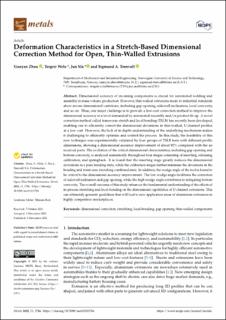| dc.contributor.author | Zhou, Xianyan | |
| dc.contributor.author | Welo, Torgeir | |
| dc.contributor.author | Ma, Jun | |
| dc.contributor.author | Tronvoll, Sigmund A. | |
| dc.date.accessioned | 2023-02-24T12:56:36Z | |
| dc.date.available | 2023-02-24T12:56:36Z | |
| dc.date.created | 2021-11-22T13:43:31Z | |
| dc.date.issued | 2021 | |
| dc.identifier.citation | Metals. 2021, 11 (11), . | en_US |
| dc.identifier.issn | 2075-4701 | |
| dc.identifier.uri | https://hdl.handle.net/11250/3053921 | |
| dc.description.abstract | Dimensional accuracy of incoming components is crucial for automated welding and assembly in mass volume production. However, thin-walled extrusions made to industrial standards show severe dimensional variations, including gap opening, sidewall inclination, local convexity, and so on. Thus, one major challenge is to provide a low-cost correction method to improve the dimensional accuracy at a level demanded by automated assembly and/or product fit-up. A novel correction method called transverse stretch and local bending (TSLB) has recently been developed, enabling one to efficiently correct the dimensional deviations in thin-walled, U-channel profiles at a low cost. However, the lack of in-depth understanding of the underlying mechanism makes it challenging to efficiently optimise and control the process. In this study, the feasibility of this new technique was experimentally validated by four groups of TSLB tests with different profile dimensions, showing a dimensional accuracy improvement of about 92% compared with the as-received parts. The evolution of the critical dimensional characteristics, including gap opening and bottom convexity, is analysed numerically throughout four stages consisting of inserting, releasing, calibration, and springback. It is found that the inserting stage greatly reduces the dimensional deviations in a pure bending state, while the calibration stages further minimise the deviations in the bending and transverse stretching combined state. In addition, the wedge angle of the tool is found to be critical to the dimensional accuracy improvement. The low wedge angle facilitates the correction of sidewall inclination and gap opening, while the high wedge angle contributes to mitigating bottom convexity. The overall outcome of this study enhances the fundamental understanding of the effects of in-process stretching and local-bending on the dimensional capabilities of U-channel extrusions. This can ultimately generate guidelines that will lead to new application areas of aluminium extrusions in highly competitive marketplaces. | en_US |
| dc.description.abstract | Deformation characteristics in a stretch-based dimensional correction method for open, thin-walled extrusions | en_US |
| dc.language.iso | eng | en_US |
| dc.relation.uri | https://doi.org/10.3390/met11111786 | |
| dc.rights | Navngivelse 4.0 Internasjonal | * |
| dc.rights.uri | http://creativecommons.org/licenses/by/4.0/deed.no | * |
| dc.title | Deformation characteristics in a stretch-based dimensional correction method for open, thin-walled extrusions | en_US |
| dc.title.alternative | Deformation characteristics in a stretch-based dimensional correction method for open, thin-walled extrusions | en_US |
| dc.type | Journal article | en_US |
| dc.type | Peer reviewed | en_US |
| dc.description.version | publishedVersion | en_US |
| dc.source.pagenumber | 16 | en_US |
| dc.source.volume | 11 | en_US |
| dc.source.journal | Metals | en_US |
| dc.source.issue | 11 | en_US |
| dc.identifier.doi | 10.3390/met11111786 | |
| dc.identifier.cristin | 1957324 | |
| dc.relation.project | Norges forskningsråd: 267768 | en_US |
| dc.relation.project | Norges forskningsråd: 321571 | en_US |
| cristin.ispublished | true | |
| cristin.fulltext | original | |
| cristin.qualitycode | 1 | |

